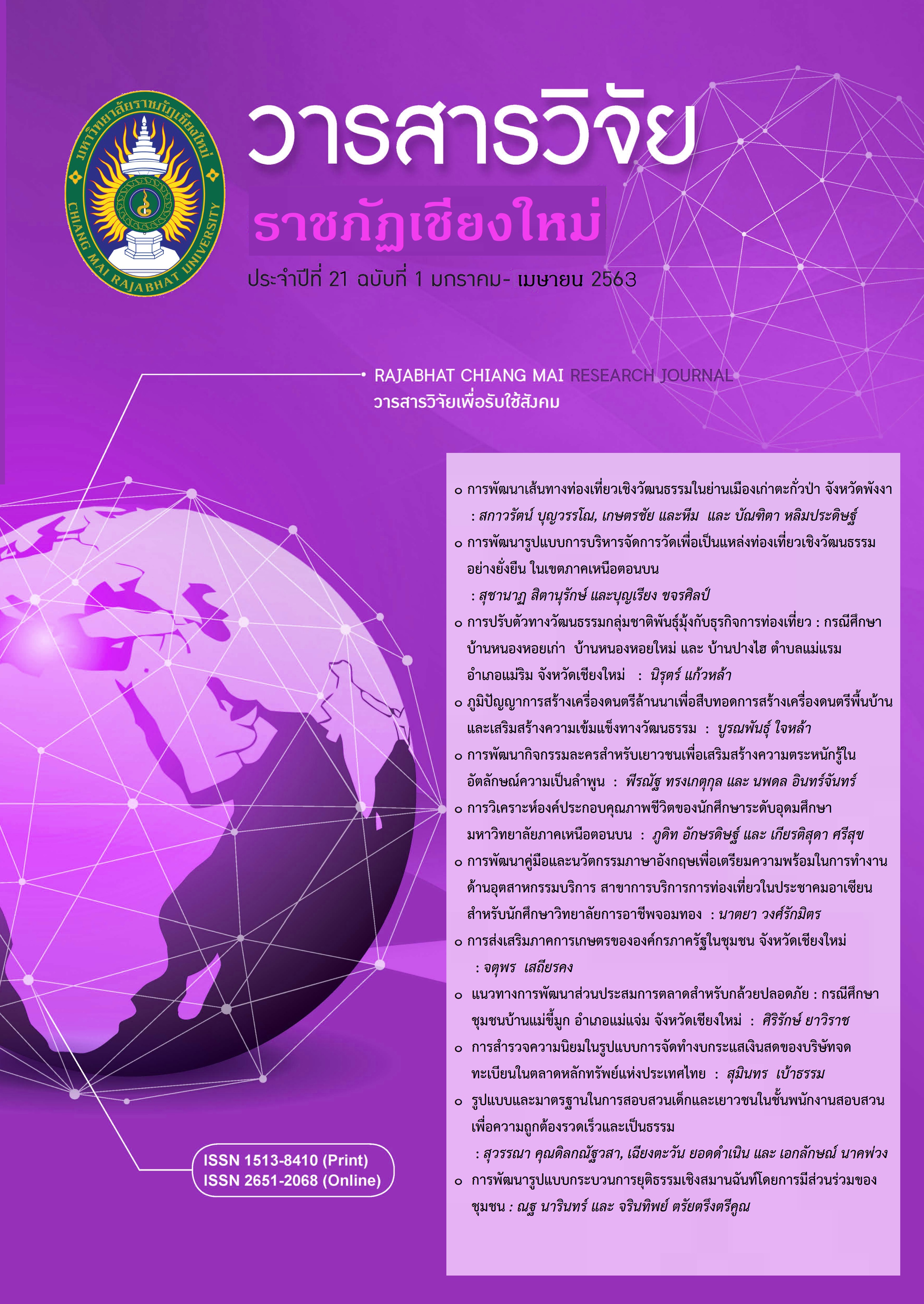The Local Wisdom of Lanna Musical Instrument for Inherit the making Lanna Musical Instrument and Support the Strengthening Culture
DOI:
https://doi.org/10.14456/rcmrj.2020.216271Keywords:
Local wisdom, Lanna musical instrument, Inherit the making Lanna musical instrument, Strengthening cultureAbstract
Salor and Sueng is an Lanna musical instrument and popular to play in present day. The quality of musical instrument is depend on material for making and musical instrument maker skill. This research aims to study the development of Lanna music making knowledge transmission from Master Boonrat Tippayarat, Lanna musical instrument maker in Chiang Mai province and the process of making Lanna musical instrument. Ethnomusicological method used for this study.
The result of this research shows the first standard Lanna musical instrument maker is Jao Suntorn Na Chiang Mai and transmit to Master Boonrat Tippayarat. The process of learning to make musical instrument by observation and practice by doing. Master Boonrat Tippayarat transmit the musical instrument making to Master Khamjorn Thevokut, specialize to make Salor and Sueng in the present day. The process of Salor and Sueng making; small size, medium size and large size making is difference by nature of musical sound.
Downloads
References
กิจชัย ส่องเนตร. (2554). การสืบทอดสะล้อในวัฒนธรรมดนตรีล้านนา. (วิทยานิพนธ์ปริญญาปรัชญาดุษฎีบัณฑิต (ดนตรี)). มหาวิทยาลัยมหิดล. นครปฐม.
กำจร เทโวขัติ. (2561). บุคคลข้อมูล. สัมภาษณ์ 4 มีนาคม 2561.
งามตา นันทขว้าง. (2551). ศรีกุย ปันแสง ช่างทำเครื่องดนตรีพื้นบ้านล้านนา. (วิทยานิพนธ์ปริญญา ศิลปศาสตรมหาบัณฑิต สาขาวิชาดนตรีชาติพันธุ์วิทยา). มหาวิทยาลัยเกษตรศาสตร์. กรุงเทพมหานคร.
ธีรยุทธ ยวงศรี. (2540). การดนตรี การขับ การฟ้อน ล้านนา. เชียงใหม่ : สุริวงค์บุ๊คเซนเตอร์.
บุญรัตน์ ทิพยรัตน์. (2561).บุคคลข้อมูล.สัมภาษณ์ 9 กุมภาพันธ์ 2561.
ปณิธิ เถาทอง. (2548). ขลุ่ยพื้นเมืองในวัฒนธรรมล้านนา. (วิทยานิพนธ์ปริญญาศิลปศาสตรมหาบัณฑิต สาขาวิชาดนตรี). มหาวิทยาลัยมหิดล. นครปฐม.
ปรเมศวร์ สรรพศรี. (2555). เจ้าสุนทร ณ เชียงใหม่ : การสืบทอดภูมิปัญญาการสร้างสะล้อและซึง. (วิทยานิพนธ์ปริญญาศิลปศาสตร มหาบัณฑิต วัฒนธรรมและการพัฒนา). มหาวิทยาลัยมหิดล. นครปฐม.
ประเวศ วะสี. (2530). การสร้างภูมิปัญญาไทยเพื่อการพัฒนา. กรุงเทพมหานคร: สำนักงานคณะกรรมการวัฒนธรรมแห่งชาติ.
รณชิต แม้นมาลัย. (2536). กลองหลวง : ความสัมพันธ์ระหว่างชีวิตและชาติพันธุ์. (วิทยานิพนธ์ ปริญญาศิลปศาสตรมหาบัณฑิต สาขาวิชาวัฒนธรรมศึกษา). มหาวิทยาลัยมหิดล. นครปฐม.
รัฐสินธุ์ ชมสูง. (2560). วงสะล้อ ซอ ปิน ของครูอรุณศิลป์ ดวงมูล. วารสารวิจัยราชภัฏเชียงใหม่, 18(2), 6-20.
วาสิษฐ์ จรัณยานน์. (2538). สวนฯ เล่มน้อย. (พิมพ์ครั้งที่ 1) . กรุงเทพมหานคร: สถาบันราชภัฏจันทรเกษม.
สงกรานต์ สมจันทร์. (2559). ประวัติดนตรีล้านนา. (พิมพ์ครั้งที่ 1). กรุงเทพมหานคร: จรัลสนิทวงค์การพิมพ์.
สุคำ แก้วศรี. (2553). สะล้อและซึง ภูมิปัญญาดนตรีพื้นบ้านล้านนา. (วิทยานิพนธ์ปริญญาศิลปศาสตรมหาบัณฑิต สาขาวิชาวัฒนธรรมศึกษา). มหาวิทยาลัยแม่ฟ้าหลวง. เชียงราย.
สำนักงานเลขาธิการสภาการศึกษา. (2560). ครูภูมิปัญญาไทยรุ่นที่ 8 . กรุงเทพมหานคร.
เอกพิชัย สอนศรี. (2546). ซึงในวัฒนธรรมดนตรี จังหวัดเชียงใหม่. (วิทยานิพนธ์ ปริญญาศิลปศาสตรมหาบัณฑิต สาขาวิชาดนตรี). มหาวิทยาลัยมหิดล. นครปฐม.
Downloads
Published
How to Cite
Issue
Section
License
1. Articles, information, content, images, etc published in the “Community and Social Development Journal” are copyrighted by the Community and Social Development Journal, Chiang Mai Rajabhat University. In order to properly distribute the articles through print and electronic media, the authors still hold the copyright for the published articles under the Creative Commons Attribution (CC BY) license, which allows the re-distribution of the articles in other sources. References must be made to the articles in the journal. The authors are responsible for requesting permission to reproduce copyrighted content from other sources.
2. The content of the articles appearing in the journal is the direct responsibility of the article authors. The editorial board of the journal does not necessarily agree with or share any responsibility.














